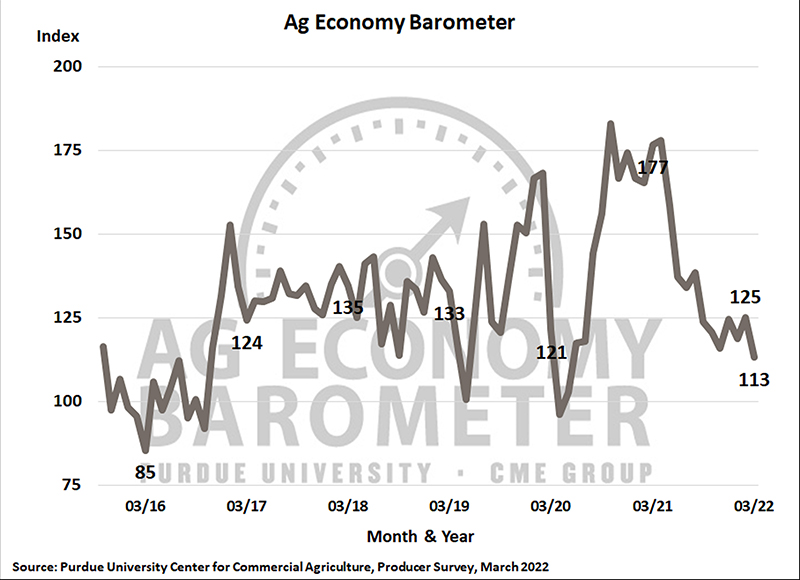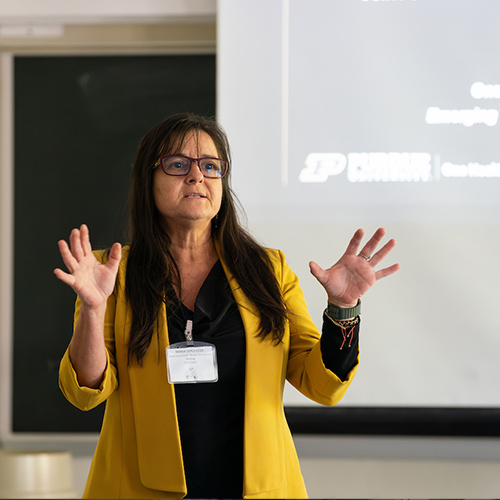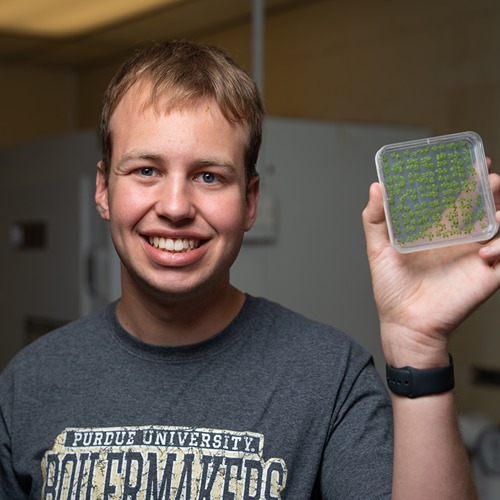Ag Economy Barometer slides lower, producers concerned about war’s impact on input prices
The Purdue University/CME Group Ag Economy Barometer dipped to a reading of 113 in March, down 12 points from February and 36% lower than March 2021, marking the weakest farmer sentiment reading since May 2020, the early days of the pandemic. The decline was driven by producers’ weaker perceptions of both current conditions in the agricultural economy and expectations for the future. The Index of Current Conditions declined 19 points to 113, down 44% from March 2021, and the Index of Future Expectations declined 9 points to 113, down 31% from the same time last year. The Ag Economy Barometer is calculated each month from 400 U.S. agricultural producers’ responses to a telephone survey. This month’s survey was conducted March 14-18.
“Concern about the war’s impact on input prices and input availability on their farming operations was paramount in the minds of producers responding to the March survey and was a major factor in this month’s decline in sentiment,” said James Mintert, the barometer’s principal investigator and director of Purdue University’s Center for Commercial Agriculture.
The March survey provided the first opportunity to ask producers how they expect the war in Ukraine to affect U.S. agriculture. Producers overwhelmingly said they expect input prices to be most affected (63% of respondents), followed by crop prices (33% of respondents), and livestock prices (3% of respondents). Responding to a related question, 19% of respondents chose “availability of inputs” as their biggest concern in their farming operation this year, which was equal to the percentage of producers who chose “lower crop and/or livestock prices” as their biggest concern.
Diving deeper into producers’ expectations for farm input prices in the upcoming year, 57% expect farm input prices to rise by 20% or more, and 36% think input prices will rise by 30% or more. And, just over one-fourth (27%) of producers say they’ve had difficulty purchasing crop inputs for the 2022 crop season. Producers report that supply chain problems persist across a wide range of inputs, with herbicides, fertilizer and farm machinery parts posing the most problems.
Producers continue to say that they expect their farm’s financial performance to decline in 2022 compared to 2021. The March Farm Financial Performance Index, which asks producers whether they expect their farm's financial performance in 2022 to be better than, worse than or about the same as in 2021, was up slightly (4 points) at a reading of 87 but remains 30% lower than a year earlier.
“When producers think about how their farm will fare financially in 2022, it’s clear they do not expect commodity price strength to offset the dramatic rise in farm production costs they are experiencing,” Mintert said.
Producers do not view this as a good time to make large investments in their farming operations as the Farm Capital Investment Index fell again in March. The index was 6 points lower than a month earlier and 59% lower than in March 2021 when it was near its all-time peak. In a pair of follow-up questions, 62% of respondents said their plans for farm machinery purchases in the upcoming year are lower than a year earlier, which is the most negative response to that question since May 2020. When asked a similar question about their plans for farm building and grain bin construction, 68% of respondents chose “lower,” which was the most negative response received to that question since its first inclusion in a barometer survey in May 2021.
Supply chain problems continue to haunt both the farm machinery and construction sectors and are one of the reasons producers don’t view this as a good time for large investments. For example, 42% of producers this month said their machinery purchase plans were impacted by low farm machinery inventories, consistent with industry reports that major machinery manufacturers are experiencing order backlogs.
Read the full Ag Economy Barometer report at https://purdue.ag/agbarometer. The site also offers additional resources – such as past reports, charts and survey methodology – and a form to sign up for monthly barometer email updates and webinars.
Each month, the Purdue Center for Commercial Agriculture provides a short video analysis of the barometer results. For even more information, check out the Purdue Commercial AgCast podcast. It includes a detailed breakdown of each month’s barometer, in addition to a discussion of recent agricultural news that affects farmers.
The Ag Economy Barometer, Index of Current Conditions and Index of Future Expectations are available on the Bloomberg Terminal under the following ticker symbols: AGECBARO, AGECCURC and AGECFTEX.
About the Purdue University Center for Commercial Agriculture
The Center for Commercial Agriculture was founded in 2011 to provide professional development and educational programs for farmers. Housed within Purdue University’s Department of Agricultural Economics, the center’s faculty and staff develop and execute research and educational programs that address the different needs of managing in today’s business environment.
About CME Group
As the world’s leading and most diverse derivatives marketplace, CME Group (www.cmegroup.com) enables clients to trade futures, options, cash and OTC markets, optimize portfolios, and analyze data – empowering market participants worldwide to efficiently manage risk and capture opportunities. CME Group exchanges offer the widest range of global benchmark products across all major asset classes based on interest rates, equity indexes, foreign exchange, energy, agricultural products and metals. The company offers futures and options on futures trading through the CME Globex® platform, fixed income trading via BrokerTec and foreign exchange trading on the EBS platform. In addition, it operates one of the world’s leading central counterparty clearing providers, CME Clearing. With a range of pre- and post-trade products and services underpinning the entire lifecycle of a trade, CME Group also offers optimization and reconciliation services through TriOptima, and trade processing services through Traiana.
CME Group, the Globe logo, CME, Chicago Mercantile Exchange, Globex, and E-mini are trademarks of Chicago Mercantile Exchange Inc. CBOT and Chicago Board of Trade are trademarks of Board of Trade of the City of Chicago, Inc. NYMEX, New York Mercantile Exchange and ClearPort are trademarks of New York Mercantile Exchange, Inc. COMEX is a trademark of Commodity Exchange, Inc. BrokerTec, EBS, TriOptima, and Traiana are trademarks of BrokerTec Europe LTD, EBS Group LTD, TriOptima AB, and Traiana, Inc., respectively. Dow Jones, Dow Jones Industrial Average, S&P 500, and S&P are service and/or trademarks of Dow Jones Trademark Holdings LLC, Standard & Poor’s Financial Services LLC and S&P/Dow Jones Indices LLC, as the case may be, and have been licensed for use by Chicago Mercantile Exchange Inc. All other trademarks are the property of their respective owners.






